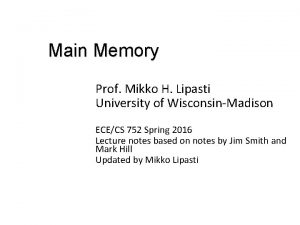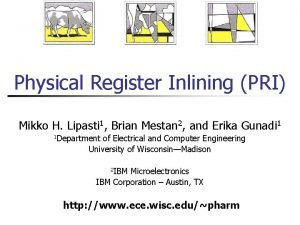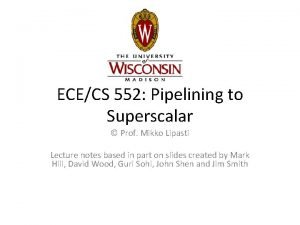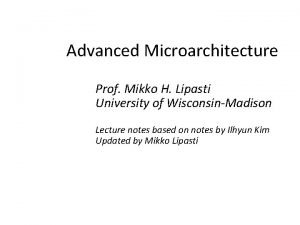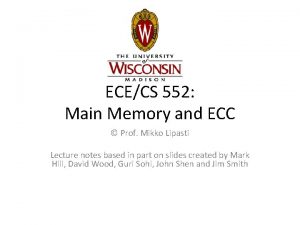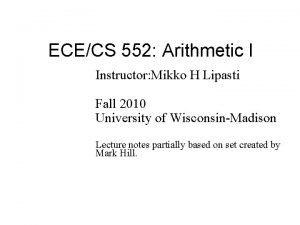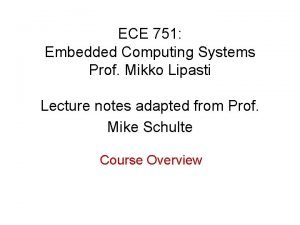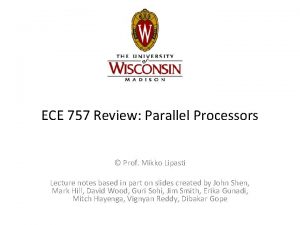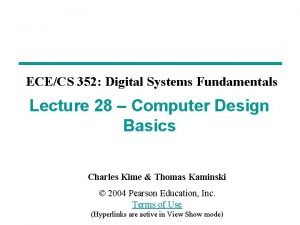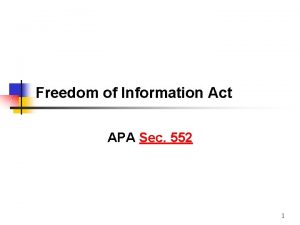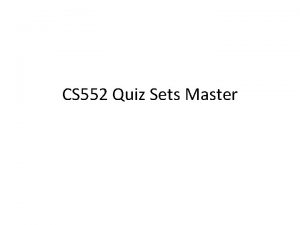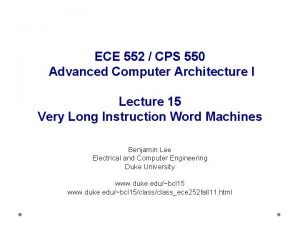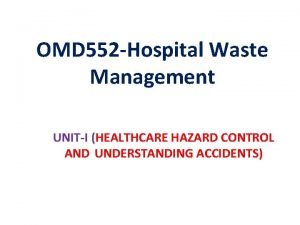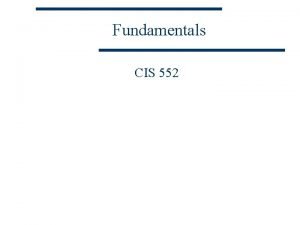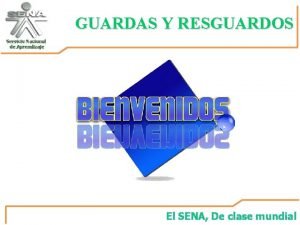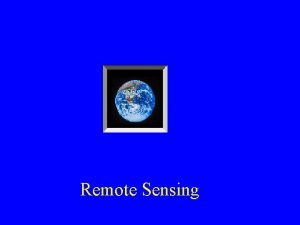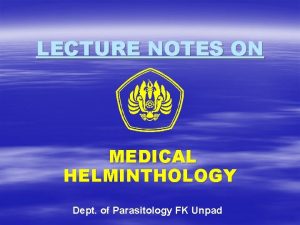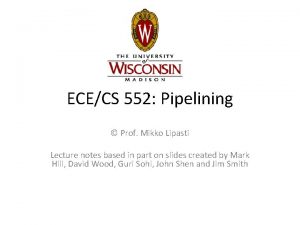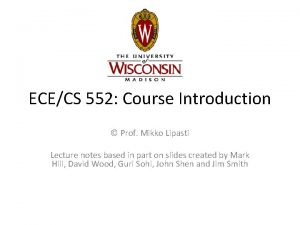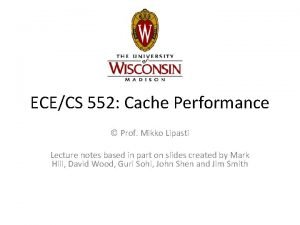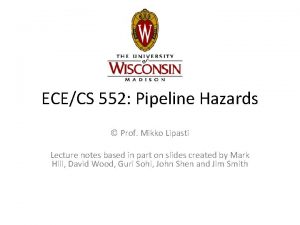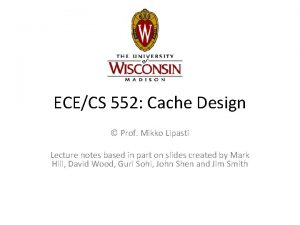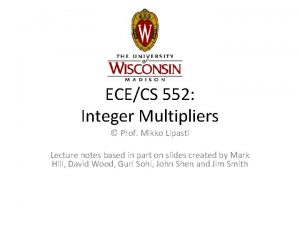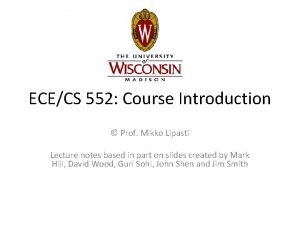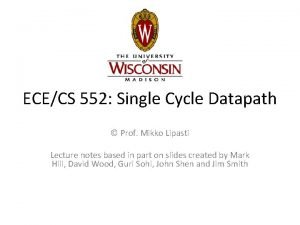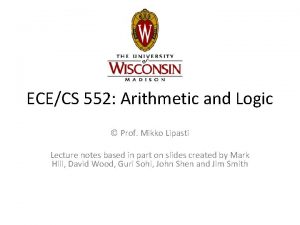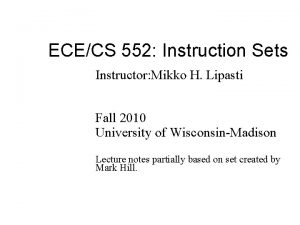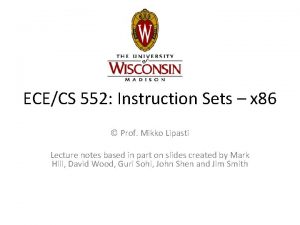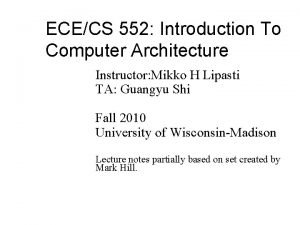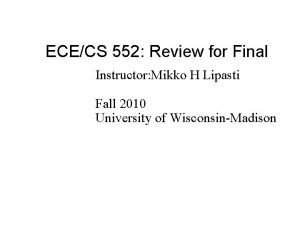ECECS 552 InputOutput Prof Mikko Lipasti Lecture notes































- Slides: 31

ECE/CS 552: Input/Output © Prof. Mikko Lipasti Lecture notes based in part on slides created by Mark Hill, David Wood, Guri Sohi, John Shen and Jim Smith

Input/Output • • • Motivation I/O Devices Buses Interfacing Examples 2

Motivation • I/O necessary – To/from users (display, keyboard, mouse) – To/from non-volatile media (disk, tape) – To/from other computers (networks) • Key questions – How fast? – Getting faster? 3

Examples Device I or O? Partner Mouse I Human Data Rate KB/s 0. 01 Display O Human 373, 000 Modem I/O Machine 2 -8 LAN I/O Machine 100, 000 Tape Storage Machine 2000 Disk Storage Machine 2000100, 000 Humans are asymmetric! 4

I/O Performance • What is performance? • Supercomputers read/write 1 GB of data – Want high bandwidth to vast data (bytes/sec) • Transaction processing: many independent small I/Os – Want high I/O rates (I/Os per sec) – May want fast response times • File systems – Want fast response time first – Lots of locality 5

Magnetic Disks Stack of platters Two surfaces per platter Tracks Heads move together Sectors Disk access Queueing + seek Rotation + transfer 6

Magnetic Disks • Seek = 10 -20 ms but smaller with locality • Rotation = ½ rotation/3600 rpm = 8. 3 ms • Transfer = x / 2 -4 MB/s – E. g. 4 k. B/4 MB/s = 1 ms • Remember: mechanical => ms 7

Disk Trends • Disk trends – – $/MB down (well below $. 10/GB) Disk diameter: 14” => 3. 5” => 2. 5” => 1. 8” => 1” Seek time down Rotation speed increasing at high end • 5400 rpm => 7200 rpm => 10 Krpm => 15 Krpm • Slower when energy-constrained (laptop, Ipod) – Transfer rates up – Capacity per platter way up (100%/year) – Hence, op/s/MB way down • High op/s demand forces excess capacity 8

RAID • What if we need 100 disks for storage? • MTTF = 5 years / 100 = 18 days! • RAID 0 – Data striped, but no error protection • RAID 1 – Mirror = stored twice = 100% overhead • RAID 5 – Block-wise parity = small overhead and small writes • Need (n+1) disks for (n) capacity – Know which disk failed => know which bit is wrong 9

GPU/Video Card • Extreme bandwidth requirement just for frame buffer – 1920 x 1080 pixels x 24 bits/pixel = 6. 2 MB – Refresh whole screen 60 times/sec = 373 MB/s ! • 3 D rendering amplifies bandwidth demand – Texture memory access, etc. • GPUs use specialized, dedicated memory (GDDRx) – APUs share DDRx memory, can’t keep up • Connected via PCIe x 16 to system memory 10

Buses in a Computer System 11

Buses • Bunch of wires – Arbitration – Control – Data – Address – Flexible, low cost – Can be bandwidth bottleneck 12

Buses • Types – Processor-memory • Short, fast, custom – I/O • Long, slow, standard – Backplane • Medium, medium, standard 13

Buses • Synchronous – has clock – – Everyone watches clock and latches at appropriate phase Transactions take fixed or variable number of clocks Faster but clock limits length E. g. processor-memory • Asynchronous – requires handshake – More flexible – I/O 14

Async. Handshake Example (1) Request made & (2) request send (3) Request deasserted & (4) ack deasserted (5) Data sent & (6) Data rec’d & (7) ack deasserted 15

Buses • Synchronous vs. asynchronous – – Must distribute clock and deal with skew Simple handshake Backward compatibility difficult, esp. with slow devices No metastability problems (FSD) 16

Buses • Improving bandwidth – Wider bus – Block transfer to exploit spatial locality – Separate address/data lines – Split transactions (multiple concurrent requests) – Pipelined in-order responses – Out-of-order responses 17

Bus Arbitration • One or more bus masters, others slaves – Bus request – Bus grant – Priority – Fairness • Implementations – Centralized vs. distributed 18

Buses • Bus standards: ISA, PCI-X, AGP, … • Currently PCIe 2. x – Serial, point-to-point topology – Bidirectional differential lanes (4 wires each) – 5 GHz signaling rate per lane – 8 b/10 b encoding for DC balance, clock recovery – 5 Gbit/sec x 10 bit/byte = 500 MB/s per lane per direction – x 1 -x 16 lanes per slot • PCIe 3. 0: 8 GHz, 128/130 b encoding 19

Interfacing • Three key characteristics – Multiple users/programs share I/O resource – Overhead of managing I/O can be high – Low-level details of I/O devices are complex • Three key functions – Virtualize resources – protection, scheduling – Use interrupts (similar to exceptions) – Device drivers 20

Interfacing • How do you give I/O device a command? – Memory-mapped load/store • Special addresses not for memory • Send commands as data • Cacheable? – I/O commands • Special opcodes • Send over I/O bus 21

Interfacing • How do I/O devices communicate w/ CPU? – Poll on devices • Waste CPU cycles • Poll only when device active? – Interrupts • Similar to exceptions, but asynchronous • Info in cause register • Possibly vectored interrupt handler 22

Interfacing • Transfer data – Polling and interrupts – by CPU – OS transfers data • Too many interrupts? – Use DMA so interrupt only when done – Use I/O channel – extra smart DMA engine • Offload I/O functions from CPU 23

Direct Memory Access (DMA) Proc Cache PCIe Bridge GPU Memory SATA 24

DMA (cont’d) • DMA – CPU sets up • Device ID, operation, memory address, # of bytes – DMA • Performs actual transfer (arb, buffers, etc. ) – Interrupt CPU when done • Typical I/O devices that use DMA – Hard drive, SSD, NIC, GPU 25

Interfacing • Caches and I/O – I/O in front of cache – slows CPU – I/O behind cache – cache coherence? – OS must invalidate/flush cache first before I/O 26

Interfacing Summary 27

Software Interfacing • I/O access provided by OS – – – Syscall interface between program and OS OS checks protections, runs device drivers Suspends current process, switches to other I/O interrupt fielded by O/S completes I/O and makes process runnable After interrupt, run next ready process • Multiprogramming 28

Multiprogramming 29

I/O System Example 30

Summary – I/O • I/O devices – Human interface – keyboard, mouse, display – Nonvolatile storage – hard drive, tape – Communication – LAN, modem • Buses – Synchronous, asynchronous – Custom vs. standard • Interfacing – Interrupts, DMA, cache coherence – O/S: protection, virtualization, multiprogramming 31
 Mikko h. lipasti
Mikko h. lipasti Mikko lipasti
Mikko lipasti Mikko h. lipasti
Mikko h. lipasti Mikko lipasti
Mikko lipasti Mikko lipasti
Mikko lipasti Mikko lipasti
Mikko lipasti Mikko h. lipasti
Mikko h. lipasti Mikko h. lipasti
Mikko h. lipasti Mikko h. lipasti
Mikko h. lipasti Mikko lipasti
Mikko lipasti Mikko lipasti
Mikko lipasti Mikko lipasti
Mikko lipasti Ececs
Ececs Inputoutput devices
Inputoutput devices 01:640:244 lecture notes - lecture 15: plat, idah, farad
01:640:244 lecture notes - lecture 15: plat, idah, farad Sec552
Sec552 Quiz
Quiz Ece552
Ece552 +1 (617) 552-2015
+1 (617) 552-2015 Omd 552 hospital waste management
Omd 552 hospital waste management Cis552
Cis552 Resguardos regulables
Resguardos regulables Ece 552
Ece 552 Lt. leak lost battalion
Lt. leak lost battalion Theology proper lecture notes
Theology proper lecture notes An introduction to atmospheric physics
An introduction to atmospheric physics Cnlrm
Cnlrm Microwave remote sensing lecture notes
Microwave remote sensing lecture notes Waves physics pdf
Waves physics pdf Bayesian classification in data mining lecture notes
Bayesian classification in data mining lecture notes Wormhost chest worm locations
Wormhost chest worm locations Power system analysis lecture notes
Power system analysis lecture notes
